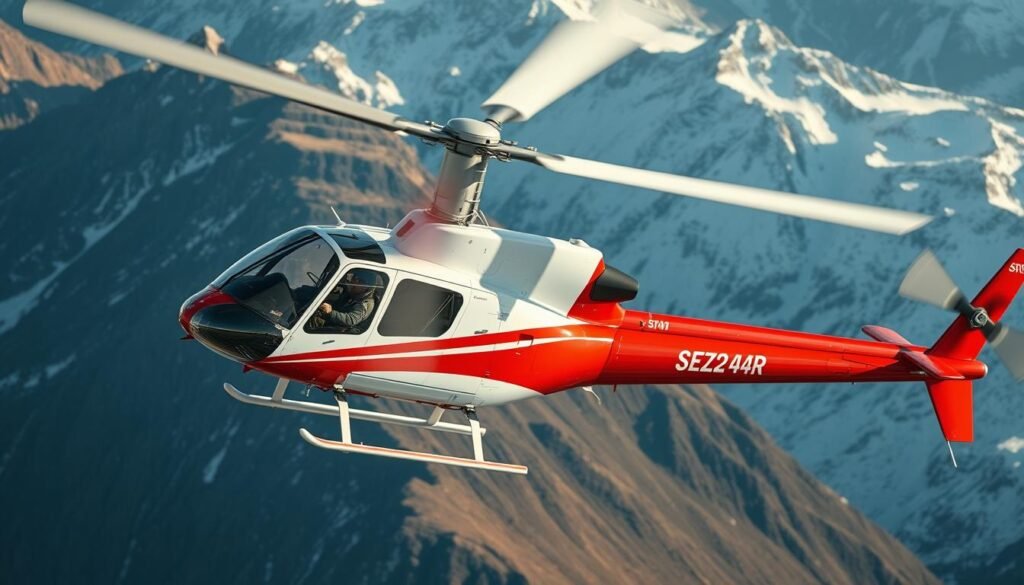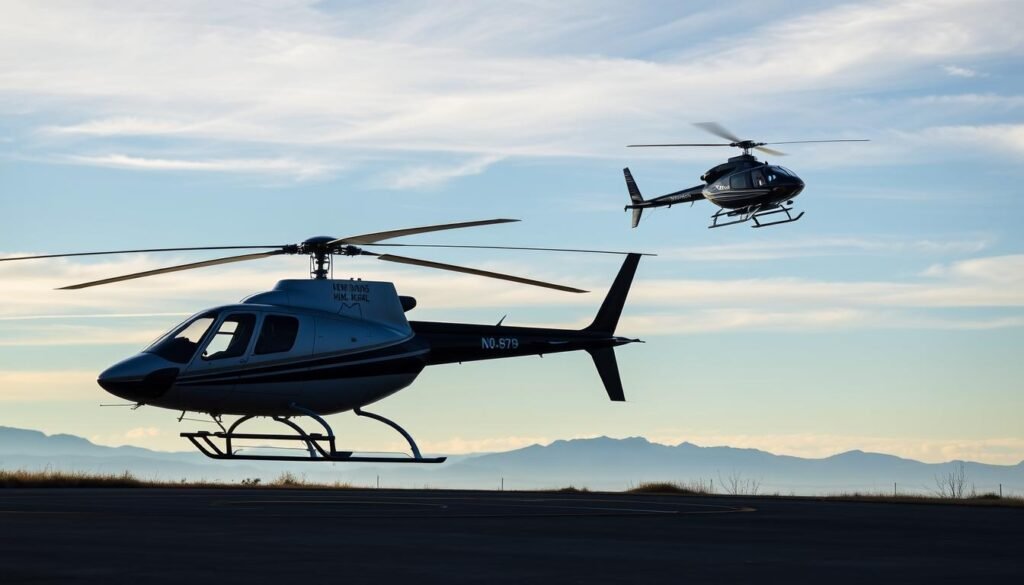Freelance helicopter pilots enjoy strong earning potential—one striking fact from the U.S. Bureau of Labor Statistics shows a median annual wage of $77,200, with entry pay starting at $39,430 and top roles reaching $147,240.
This gap shows how early choices shape earning potential and long-term standing in the industry.
They start by mapping a clear pathway from basic commercial qualifications to targeted roles. Safety, insurance minimums, and hour-building come first.
A practical plan helps a pilot stack low-risk missions to add hours while keeping proficiency and compliance front and center. Many begin with instructing, photo work, ENG, ferry, or frost protection before moving into utility, EMS, fire, agriculture, or offshore roles.
Readers who prioritize training value, mentoring quality, and hourly accumulation can turn early jobs into stepping stones. For a stepwise approach to job sequencing and career choices, see the guide on building a successful career. For tactics to grow flight hours, consult resources on how to build flight hours.
Key Takeaways
- Salary varies widely: national figures provide context but local pay depends on hours and mission complexity.
- First 200–400 hours matter: plan aircraft types, regions, and seasons to reduce gaps in recency.
- Choose jobs for training: pick roles that compound skills, mentoring, and insurance compliance.
- Stack low-risk missions: efficient hour-building boosts near-term earnings and long-term prospects.
- Diversify services: repeatable offerings like photo and ENG work stabilize income across seasons.
- Prioritize safety and discipline: operational rigor drives career resilience and employer trust.
Freelance Helicopter Pilots Market Snapshot And Buyer’s Guide Overview
Demand and pay for short-term aerial work vary sharply by region and mission type. This market snapshot helps a pilot prioritize near-term contracts that build hours and employer-ready experience.
Search Intent And Who This Guide Serves In The United States
This guide serves a pilot transitioning from training to paid work in the U.S. It focuses on practical info about jobs, qualifications, and time-to-upgrade over the next 90–180 days.
Quick Buyer’s Checklist: Jobs, Training, Hours, And Qualifications
Key decision variables: pay rate, hour guarantees, location, seasonality, and insurance minimums. Pilots should screen roles by which ones give the most controlled flight time for skill building.
- Entry roles: ENG, Photo, Ferry, Frost Protection, Co-pilot, Flight Instructor — often accessible with a few hundred hours.
- Advanced tracks: Utility, Agriculture, EMS, Fire, Offshore — typically need four-figure hours and specific signoffs.
- Onboarding prep: current logbook entries, references, aircraft signoffs, and local airspace briefings speed hiring.
| Role Type | Typical Hours Required | Near-Term Access (90–180 days) | Value For Career |
|---|---|---|---|
| ENG / Photo | 300–700 | High in metro areas | Good hourly exposure; portfolio building |
| Flight Instructor / Co‑Pilot | 200–1,000 | Moderate; depends on school/operator | Fast hours accumulation; structured training |
| Utility / EMS / Offshore | 1,500+ | Low unless four-figure hours met | High pay; specialized experience |
Practical tip: Compare offers not just on hourly pay but on guaranteed flight time, aircraft type, and employer training support. For salary context and employer comparisons, see the helicopter pilot salary range.
Qualifications, Training, And Time Building For Freelance Helicopter Pilots
A focused qualifications path and realistic time targets accelerate a pilot’s move into paid work. Clear signoffs, insurer thresholds, and seasonal planning shape the fastest route from initial ratings to steady contractor roles.

Licenses And Safety: Commercial, CFI, SFAR 73 Signoff, And Robinson Factory Safety Course
SFAR 73 signoff is required by a DPE to instruct in R22/R44. The Robinson Factory Safety Course is highly recommended and is a requirement for some underwriters.
Pathfinder Indemnity Co. Ltd. often lists the Robinson course and 300 total helicopter hours as underwriting minima, which speeds hiring and reduces paperwork delays.
Low-Hour Pathways: Time Building Offers, Intern Programs, And Insurance Minimums At 300 Hours
Low-hour programs commonly bill around $300 per flight hour for time building. Many use an internship model: unpaid supervised hours up to 300, then matched paid hours once the threshold is met.
Budget planning should account for roughly $30,000 to buy 100 hours from 200 to 300 in this model. Candidates must confirm written terms and any weight limits before committing.
Instructor Track: CFI Helicopter Pilot Jobs, Pay Rates, And Supervised Experience
R22 CFI positions paying about $50/hour are available for instructors with SFAR 73 signoff. These roles provide structured oversight and repeatable experience that build competence and loggable hours.
Budgeting And Timeline: From 200 To 400 Hours, Seasonal Flying, And Cost Per Flight Hour
An example path: a pilot at 200 hours purchases 100 hours at $300/hr to reach 300, then earns ~100 paid contractor hours to hit 400. This sequence often completes across two busy seasons.
- Confirm insurer minimums and aircraft endorsements early.
- Prefer spring–fall scheduling to maximize flight time.
- Vet internship supervision, written guarantees, and logging practices.
“Contact operations like Tom or Tommy McDermott at 561-346-2816 for current availability and requirements.”
For structured paths and formal training modules, see the recommended flight training options to align qualifications with market requirements.
Entry-Level Jobs To Build Experience And Flight Hours
Practical, high-frequency missions are the fastest path to reliable hours and documented experience for a new helicopter pilot.

Photo flights reward precise aircraft positioning and assertive safety calls. They deliver steady flight exposure and decision-making under benign but variable conditions.
ENG work places a pilot in busy metro airspace. Coordination with ATC and other crews improves radio skills and spacing judgment.
Ferry assignments add cross-country time quickly. They require conservative go/no-go decisions, fuel planning, and route discipline.
Frost protection is low-and-slow night work in types like the R22 or R44. Pilots must watch wires, manage fatigue, and maintain obstacle awareness.
Co-Pilot And Tour Opportunities: When And How They Open Up
Co-pilot roles on larger twins sometimes accept candidates with a few hundred hours. They expose a pilot to SOPs, CRM, and structured upgrades.
Tour jobs build repetitive takeoff and landing skills and front-line customer service. Local insurance minima often determine when these jobs become available.
Flight Instructor Positions: Ground School, Circuits, And Hour Accumulation
Instructor roles commonly start near 200 hours with the right rating and signoffs. Circuits, maneuvers, and ground school convert training into billable hours fast.
Practical tip: Sequence shifts to maximize hour density—ENG mornings, photo midday, and instruction blocks in the afternoon—then document references. For salary context and employer comparisons, see starting salary.
“Choose employers with clear SOPs and structured supervision; good references are the fastest ticket to higher-stakes jobs.”
Advancing Your Career: Utility, EMS, Fire, Agriculture, And Offshore
A measured move into senior roles means weighing mission type, required hours, and the employer’s support systems. Most advanced jobs become viable around 1,000 hours, though co‑pilot exceptions exist for well-referenced candidates.
Utility work gives variety and steady helicopter hours across pipeline surveys, event transport, and photo missions. EMS offers schedule stability and community impact; candidates should confirm instrument currency and minimum hours before committing.

Evaluating Employers And Contracts: Pay Structures, Hour Guarantees, Seasons, And Location
Compare pay by mission rate, per diem, and benefits. Check whether hours are guaranteed and how seasonal cycles affect flight time and earnings.
Evaluate safety records, maintenance standards, and training pipelines. Speak directly with current staff to learn about real upgrade pathways and day-to-day hour opportunities.
- Fire: high tempo, multi-ship operations, dense radio work; needs judgment under pressure.
- Agriculture: precision flying, early starts, seasonal peaks; expect operator-specific training.
- Offshore: rotations and IFR progression; weather and SOPs shape lifestyle and pay.
Training for these roles should include mission checkouts, recurrent courses, and instrument currency where required. Keep meticulous logs of hours by mission type to prove experience.
“Negotiate clarity on minimum hours, schedule predictability, and relocation support before signing any contract.”
For compensation context and career planning, consult the professional pilot earnings guide to compare pay models and growth trajectories.
Conclusion
Steady, planned hour-building unlocks higher-value roles and consistent pay over time. A pilot who consolidates early helicopter experience, meets insurer and safety standards, and sequences instruction, photo, ENG, ferry, or frost work will build hours efficiently and show readiness for advanced work.
Contracts must be vetted for hour guarantees, safety oversight, and upgrade paths. A job that pairs reliable flight with structured training is more valuable than a higher rate with irregular time aloft.
Maintain recency, log hours by mission type, and refresh credentials to access selective, higher-paying roles. Over five to ten years, disciplined choices typically lead to utility, EMS, fire, agriculture, and offshore opportunities tied to higher responsibility and pay.
Use national salary context as a benchmark, not a promise—negotiate locally on mission, schedule, and support to build a resilient career.
FAQ
What qualifications are required to start a career as a freelance helicopter pilot?
To begin, a candidate needs a private pilot certificate with a rotorcraft rating, then a commercial certificate. Many employers also expect a CFI or CFII for time building and teaching. Additional endorsements such as instrument (IFR) and type-specific training for Robinson or other makes improve employability. Medical certification, background checks, and recurrent safety courses are standard prerequisites.
How many flight hours are typically needed to meet insurance minimums and get hired?
Insurance minimums vary by operator and mission type. Many entry opportunities accept pilots at 200–300 hours, but common insurance thresholds are 300 hours for single-engine hire and 1,000+ hours for offshore or EMS work. Accumulating diverse experience—cross-country, night, and instrument—makes pilots more attractive even if total hours are low.
What are common pathways to build hours quickly and legally?
Time building routes include instructing as a CFI, taking on ferry or photo missions, aerial surveying, and ENG (electronic news gathering) flights. Intern programs, aircraft delivery jobs, and low-cost time-building offers at training centers can accelerate hours. Pilots should track PIC time, and dual instruction limits, and maintain logbooks for hiring and insurance verification.
How does the instructor track compare to other entry-level routes?
The instructor track offers steady flight hours, structured teaching experience, and pay that often includes dual and solo instruction rates. It also provides supervised PIC time and improves aeronautical decision-making. Compared with sporadic contract work like aerial photography, instructing supplies predictable schedules and a clear progression toward higher minimums.
What training courses improve safety signoff and hireability?
Completion of a Robinson Factory Safety Course, SFAR 73 signoff where applicable, and other manufacturer-specific transition programs signal higher competence. Human factors and CRM courses, night vision goggle training for night ops, and IFR competency checks further enhance safety credentials and marketability.
How should pilots budget time and money from initial training to 400 hours?
Budgeting should include hourly flight costs, instructor fees, aircraft rental or lease, fuel, insurance, and exam costs. Many pilots plan a timeline of 12–24 months to reach 400 hours depending on training intensity and seasonal flying. Cost per flight hour varies widely by aircraft type; creating a monthly budget and seeking part-time instructing or contract work can offset expenses.
What entry-level jobs commonly accept low-hour pilots?
Entry roles that often accept lower-hour pilots include aerial photography, ENG, ferry flights, frost protection work, and some tour co-pilot positions. Agricultural spraying and utility line work usually require more experience. Availability depends on regional demand and operator insurance policies.
When do co-pilot and tour pilot opportunities become available?
Co-pilot roles on multi-crew aircraft typically require higher minimums, often 500–1,000 hours depending on operator. Tour pilot opportunities may open earlier, especially for co-pilot or secondary pilot positions, when a candidate demonstrates reliability, customer service skills, and night or mountain flying experience if applicable.
What should pilots look for when evaluating employers and contracts?
Key factors include pay structure (hourly vs. salary), overtime rules, hour guarantees, seasonal demand, housing or per diem, equipment condition, maintenance standards, and insurance coverage. Pilots should review duty/rest policies, contract duration, termination clauses, and whether the operator supports additional training and checkrides.
Which advanced sectors pay best and what do they require?
Offshore oil support, EMS, and specialized utility work often pay the highest rates. These sectors demand substantial turbine time, instrument proficiency, and mission-specific training such as hoist operations or NVG. Employers in these fields usually require strict medical standards, background checks, and verified multi-engine or turbine experience.
How can a pilot transition from entry-level roles to utility, EMS, or offshore work?
The transition requires targeted training, accumulating turbine and multi-engine hours, and gaining mission-relevant experience (hoist, hoisting, NVG, mountain flying). Networking, obtaining references from reputable operators, and maintaining a clean safety record speed the move. Many pilots use instructor and tour roles as stepping stones while actively pursuing endorsements and course completions.
What are insurance and regulatory considerations for independent contract pilots?
Independent contractors must secure professional liability and hull insurance if not provided by the operator. They must comply with FAA regulations, maintain a current medical certificate, and ensure their logbook entries and endorsements meet the operator’s insurer requirements. Contract terms should clarify who covers maintenance, insurance, and regulatory compliance.
Related Articles
- Women in Helicopter Aviation: Breaking Barriers and Building a Career
- Freelance Helicopter Pilots: How to Build a Successful Career
- Helicopter Pilot Licensing Requirements: A Global Overview
- How to Network and Advance Your Career as a Helicopter Pilot
- What to Expect in Your First Year as a Commercial Helicopter Pilot
More from This Category
- Work-Life Balance for Helicopter Pilots: Managing a Demanding Career
- How to Transition from Fixed-Wing to Helicopter Flying: Tips for Pilots
- The Best Industries for Helicopter Pilots: Job Opportunities Beyond Passenger Transport
- Medical Requirements for Helicopter Pilots: What You Need to Know
- How to Build Flight Hours as a New Helicopter Pilot
- Essential Skills Every Helicopter Pilot Needs to Succeed
- Top Helicopter Pilot Training Schools: How to Choose the Best Program
- Private vs. Commercial Helicopter Pilot: Which Career Path Is Right for You?
- Helicopter Pilot Salary: What You Can Expect at Every Stage of Your Career
- How to Become a Helicopter Pilot: A Step-by-Step Guide



